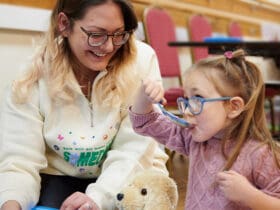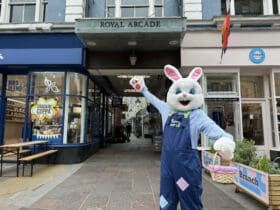When choir singer Kristina Wishart had investigations for suspected endometriosis, she was shocked to be diagnosed with a large cancerous tumour in her kidney.
After beating kidney cancer in 2003 Kristina was then diagnosed with a rare eye cancer in 2013.
Now cancer free, the mum-of-two is preparing to help mark 30 years of Cancer Research UK’s Race for Life by joining the hundreds of women, men and children at the events on 29 July at Singleton Park and 30 July at Museum Green.
And to celebrate the milestone she’ll be joined by fellow members of the DVLA choir have been chosen to perform on both days to transport the crowds back in time by belting out 1990s hits.
Kristina, 45, who works in the Drivers’ Medical team at the DVLA, was referred to the gynaecology department at Singleton Hospital in 2001 after experiencing severe abdominal pains which left her unable to walk.
After waiting two years for investigations, a scan in 2003 revealed a rugby-ball sized tumour in her kidney.
Just 25 at the time, she was shocked when she was diagnosed with chromophobe carcinoma – a rare type of kidney cancer that forms in the cells lining the small tubules in the kidney.
She said: “I’d been experiencing a lot of pain in my abdomen. It would get so bad I’d be unable to walk. At first doctors wondered whether it could be IBS, but with pain hitting a peak around my period, my GP referred me to the gynaecology department, suspecting it could be endometriosis.”
The wait to be seen was long and Kristina feels for anyone going through diagnosis for endometriosis.
“It took a year for my gynae appointment to come and then they wanted me to have an ultrasound to see what was going on. That took a further year to come through,” said Kristina.
The ultrasound found a growth on Kristina’s kidney, and she was scheduled for a follow-up contrast dye CT scan the following day. The scan showed her kidney was enlarged – instead of being four to five inches long, it was the size of a rugby ball.
“My consultant wanted to remove the kidney given its size but at no point did we discuss the possibility of cancer. It didn’t even cross my mind.
“The prospect of surgery was scary – I was in my early 20s and it was a big op – six hours long. When I came round, I thought I’d died – the drugs and anaesthetic hadn’t worn off and I saw one of my consultants back-lit by a bright light. I thought he was an angel come to take me to heaven.”
A month post-surgery in a routine check-up, Kristina was shocked to be told that her kidney had been cancerous.
Kristina, of Gendros in Swansea, explained: “It was a bizarre situation to be in because I’d effectively started with treatment and finished with diagnosis. For most people with cancer, it’s the other way round. But thankfully, the cancer hadn’t spread, and I didn’t need any further treatment.”
For the 10 years that followed, Kristina had routine check-ups with chest x-rays, CT scans and blood tests and was deemed cancer free.
However, in 2011, at a routine sight test, opticians found a small mole on the back of Kristina’s eye. She was referred to the Ophthalmology department at Singleton Hospital for more in-depth tests. The mole was measured and, because it was close to the size which is typically a sign of cancer, she was referred to St Paul’s Eye Unit in Liverpool for further investigation.
Kristina said: “Locally, the machines weren’t sophisticated enough to get precise measurements, but the specialists in Liverpool were able to confirm the mole was 1.8mm in diameter. Anything over 2mm is usually an indicator of cancer – but it wasn’t that big, so they were content to refer me back to Singleton and my opticians for monitoring.”
Everything seemed fine, but in 2013, Kristina’s optician found that the mole had grown: “Knowing that an increase in size could mean cancer, I went home and cried”.
Kristina was referred back to St Paul’s Eye Unit where they confirmed her worst fears – she had ocular melanoma. She was then referred to Clatterbridge Hospital on the Wirral for proton beam therapy – an advanced type of radiotherapy.
“Four weeks after my treatment finished, I developed a burn on my eyelid – a delayed side effect of the radiotherapy. A clump of eyelashes fell out too and have never grown back.”
Kristina’s distance and peripheral vision have been reduced as a result of the radiation and she has injections every 8-10 weeks to stop blood vessels leaking and damaging her sight further. She continues to be monitored with scans, blood tests and regular vision checks, but she is pleased to be ten years cancer-free this year.
Now, Kristina is looking forward to singing with her DVLA Choir colleagues at Swansea’s Race for Life events on 29 and 30 July.
She said: “We all have a reason to Race for Life. For me, supporting alongside the DVLA choir, is my way of saying thank you for research which develop kinder, and more precise treatments for people like me.”
Members of the DVLA choir have been chosen to help celebrate 30 years of the renowned event series by transporting the crowds back to the 1990s with a selection of hits from that decade including Hold On by Wilson Phillips and I Will Follow Him from Sister Act.
Cancer Research UK’s Race for Life, in partnership with headline sponsor Standard Life, part of Phoenix Group, is an inspiring series of 3k, 5k, 10k, Pretty Muddy and Pretty Muddy Kids events which raise millions of pounds every year to help beat cancer by funding crucial research.
This year, participants will receive an exclusive medal to mark the 30th year milestone.
The first Race for Life event was held in Battersea, London in 1994, where 750 participants raised £48,000. It was so successful that the following year, the event was extended to six venues across the UK. Today around 450 Race for Life events are held every year and since it began more than £940m has been raised to fund life-saving research. Race for Life is today open to everyone, no matter their fitness level, background, or gender.
Every year around 19,800 people are diagnosed with cancer in Wales** and one in two people in the UK born after 1960 will get cancer in their lifetime.*** Money raised at Race for Life enables scientists to find new ways to prevent, diagnose and treat cancer - helping to save more lives.
Cancer Research UK’s spokesperson in Wales, Emma Howell, said: “We are grateful to the DVLA choir for their support.
“We’d love for as many people as possible from Swansea and beyond to join us during our 30th year of Race for Life. Sadly, cancer affects all of us in some way.
“We went to make sure that everyone can join the Race for Life movement. Our participants come from different backgrounds, with different stories, but with one thing in common – the determination to help beat cancer. Whether people are living with cancer, taking part in honour of or in memory of a loved one with cancer, or signing up to protect their own children’s future, everyone has a reason to Race for Life.
“We’ve seen survival rates in the UK double in the last forty years thanks to the tireless efforts of researchers, but this can only happen with the continued support of fundraisers up and down the country.”
Chief executive of Standard Life, part of Phoenix Group, Andy Curran, said: “We are extremely proud to have been chosen as the headline sponsor of Cancer Research UK’s Race for Life. This sponsorship will help encourage participation and raise funds for life-saving research to help beat cancer.”
To enter, visit raceforlife.org









Leave a Reply
View Comments